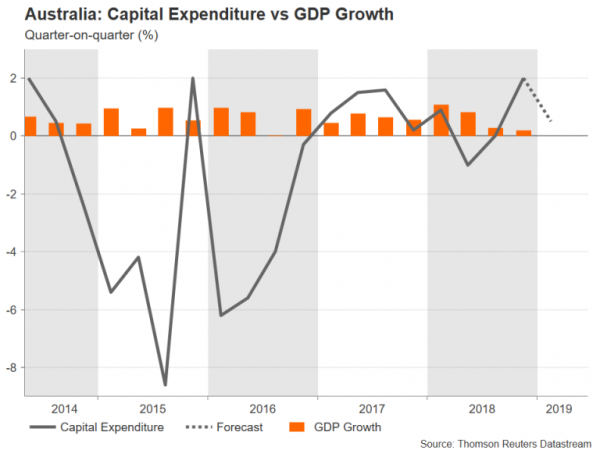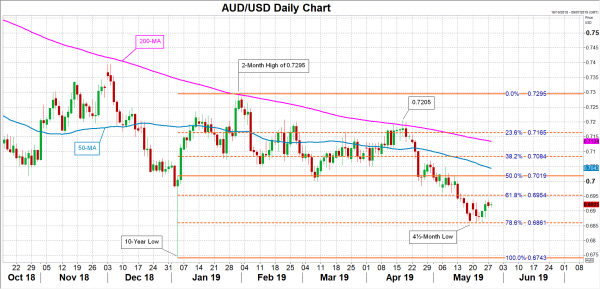Capital expenditure figures from Australia will be watched on Thursday (due at 01:30 GMT) as they will be a prelude to Q1 GDP estimates released the following week. With market expectations running high that the RBA will cut rates at its next meeting, a feeble reading would almost certainly fuel such bets. Having formed a floor after its recent slide, the Australian dollar appears at risk of breaking below this support as rate cut odds increase.
Economic data out of Australia hasn’t been that great of late, prompting a rethink at the Reserve Bank of Australia, which has long been insisting that growth and inflation would bounce back towards the end of 2019. But with inflationary pressures subsiding further during the first quarter and even the labour market – the economy’s bright spot – starting to show some signs of weakness, the prospect of a turnaround is fast fading.
Growth in capital spending likely slowed in Q1
Next week’s releases could ease the dilemma for policymakers if they highlight the slowdown in growth. Business spending is forecast to have expanded by 0.5% quarter-on-quarter in the first three months of the year, moderating from the prior quarter’s 2% gain. The risk of a negative surprise is greater than a positive one given that mining investment is still on a downtrend and the construction sector has been struggling. Construction work done fell by 1.9% q/q in the first quarter as residential building work continued to decline.
Other data on Thursday will include April building approvals, as well as private sector lending figures on Friday. RBA board members will also be able to take a glimpse at Q1 business inventories and net trade numbers ahead of their policy decision on June 4.
RBA is poised to cut rates in June; aussie at risk of downside
If the incoming data confirms that the RBA is poised to cut rates in June, the Australian dollar is likely to face some selling pressure. The aussie has been trading between the 61.8% and 78.6% Fibonacci retracement levels of the upleg from $0.6743 to $0.7295 for the past two weeks. That provides the aussie with immediate resistance at $0.6954 and a floor at $0.6861.
Breaking below the support at the 78.6% Fibonacci could set the stage for sharper declines. However, with a rate cut now almost fully priced in by the markets (the odds are currently slightly above 88%), the likelihood of a steep sell-off will depend on how many more rate cuts will be on the horizon after the June meeting.
Outlook is clouded by trade war
The outlook for the Australian economy has become increasingly clouded by the recent heating up of trade tensions between the US and China – Australia’s biggest export market – and sluggish growth elsewhere in the world. As things stand, it will be difficult for the RBA to ignore the growing downside risks and many are predicting the bank will have to cut rates twice this year. That may well be enough to keep growth rolling until the government has implemented all of its planned tax cuts.















